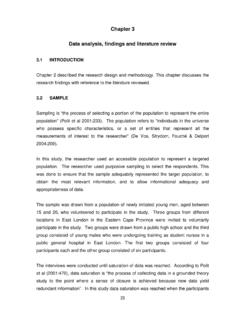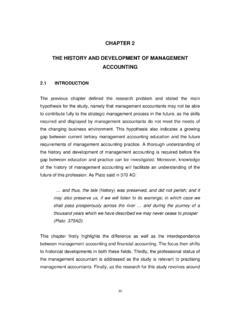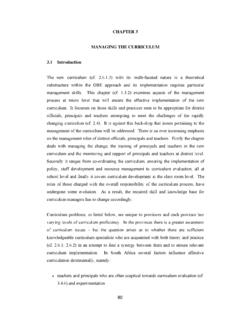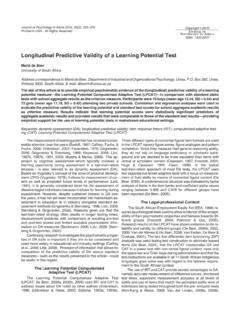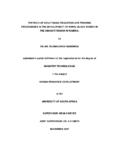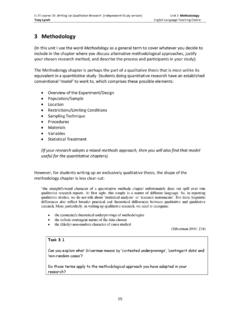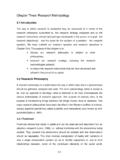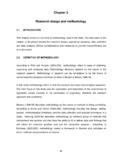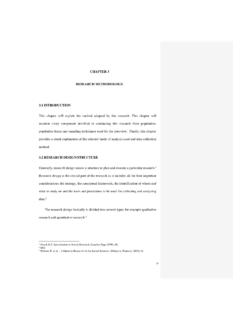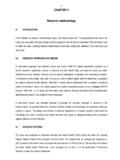Transcription of CHAPTER 3 Research design and methodology
1 51 CHAPTER 3 Research design and methodology INTRODUCTION This CHAPTER covers the Research design and methodology , including sampling, population, establishing rigour during and after data collection, ethical considerations and data analysis. Research design burns and grove (2003:195) define a Research design as a blueprint for conducting a study with maximum control over factors that may interfere with the validity of the findings . Parahoo (1997:142) describes a Research design as a plan that describes how, when and where data are to be collected and analysed . Polit et al (2001:167) define a Research design as the researcher s overall for answering the Research question or testing the Research hypothesis . This study focuses on the opinion of nurses on pain in patients that suffer from dementia.
2 The Research approach is non-experimental, qualitative, exploratory-descriptive and contextual. Non-experimental Research According to Polit et al (2001:178), non-experimental Research is used in studies whose purpose is description and where it is unethical to manipulate the independent variable. Non-experimental Research is suitable for the study of people in nursing for several reasons. First, due to ethical considerations manipulation of the human variable is not acceptable because of the potential for physical or mental harm to the participants. Secondly, human characteristics are inherently not subject to experimental manipulation, 52such as health beliefs and opinions. Thirdly, Research constraints such as time, personnel and the type of participants, make non-experimental Research more feasible.
3 Lastly, qualitative studies do not interfere with the natural behaviour of participants being studied; the type of Research question would not be appropriate for an experimental Research (Polit et al 2001:178). In this study data were collected without introducing any treatment. Qualitative Research burns and grove (2003:19) describe a qualitative approach as a systematic subjective approach used to describe life experiences and situations to give them meaning . Parahoo (1997:59) states that qualitative Research focuses on the experiences of people as well as stressing uniqueness of the individual. Holloway and Wheeler (2002:30) refer to qualitative Research as a form of social enquiry that focuses on the way people interpret and make sense of their experience and the world in which they live . Researchers use the qualitative approach to explore the behaviour, perspectives, experiences and feelings of people and emphasise the understanding of these elements.
4 Researchers who use this approach adopt a person-centred holistic and humanistic perspective to understand human lived experiences without focusing on the specific concepts (Field & Morse 1996:8). The researcher focused on the experiences from the participants perspective. In order to achieve the emic perspective, the researcher became involved and immersed in the study. The researcher s participation in the study added to the uniqueness of data collection and analysis (Streubert & Carpenter 1999:17). Complete objectivity is impossible and qualitative methodology is not completely precise because human beings do not always act logically or predictably (Holloway & Wheeler 2002:3). The rationale for using a qualitative approach in this Research was to explore and describe the opinion of nurses on pain in patients that suffer from dementia.
5 A qualitative approach was appropriate to capture the opinions of the nurses regarding pain in patients suffering from dementia. This study involved three phases, namely the conceptual, narrative and interpretative 53phases (Field & Morse 1996). Conceptual phase In the conceptual phase the Research question namely what is the perception of nurses of pain in the elderly suffering from Alzheimer s disease and objectives were formulated for the purpose of the study (see CHAPTER 1, sections and ). The Research question evolved due to the researcher s involvement in the phenomenon under investigation. A literature review was conducted to familiarise the researcher with the concept and content literature. It was necessary for the researcher to do bracketing to lay aside any pre-conceived ideas about the phenomena under study (see discussion under section ).
6 Narrative phase The narrative phase involved planning the Research design . The researcher was the main data collection instrument. A pilot study (pre-exercise) was conducted with three participants who met the sampling criteria and would not form part of the main study. Non-probability sampling was used (see discussion under section ). Interpretative phase The empirical Research phase involved data collection, analysis and interpretation. Data collection included qualitative information that was collected during a focus group interview. The researcher also searched articles to understand the context of the topic under study, for the purpose of providing a view of reality that is important to participants. Exploratory Research According to Polit et al (2001:19), explorative studies are undertaken when a new area is being investigated or when little is known about an area of interest.
7 It is used to investigate the full nature of the phenomenon and other factors related to it. In this study, the opinions of nurses regarding pain in patients who suffer from dementia were explored using a focus group interview. 54 Although Research has been conducted on pain in dementia, little is known about nurses opinion of pain in patients who suffer from dementia. Descriptive Research According to burns and grove (2003:201), descriptive Research is designed to provide a picture of a situation as it naturally happens . It may be used to justify current practice and make judgment and also to develop theories. For the purpose of this study, descriptive Research was used to obtain a picture of nurses opinions of pain in patients who suffer from dementia with a view to improving the standard of care for this group of patients.
8 Context The context is significant in qualitative Research . According to Holloway and Wheeler (2002:34), context includes the environment and conditions in which the study takes place as well as the culture of the participants and location . The participants in this study were registered nurses, registered nurses for mental health care nursing, as well as trained nursing care assistants. The setting was the Grosvenor Park Nursing Home in Bexhill-on-Sea, East Sussex in the UK. The opinions of nurses who provide care for patients who suffer from dementia cannot be studied outside their context and are, therefore, dependent on the context and the time. CONCEPTUAL PHASE In the conceptual phase the researcher formulated the Research question as well as the objectives of the study.
9 A literature review was conducted to familiarise the researcher with the content and the concepts related to this study. In addition, reflexivity, the process of bracketing and intuiting were described. Literature review According to Polit et al (2001:43), some qualitative researchers advise against a literature 55review prior to data collection because the literature review might influence the researcher s conceptualisation of the study. Field and Morse (1996:37) maintain that a literature review may mislead the researcher s ability to make accurate decisions in the study. According to this view, the phenomenon should be clarified based on the view of the participants rather than prior information. However, the researcher belief that a literature review is necessary to provide guidance in identifying bias in previous studies.
10 In this study the researcher conducted a literature review prior to submitting the Research proposal as prerequisite. The aim was to obtain background knowledge about the phenomenon under study. Thereafter an extensive literature review was conducted to orientate the researcher on concepts such as nurses opinion, pain and dementia as well as to put the current study into the context of what is known about the topic (Parahoo 1997:89). Polit et al (2001:121) maintain that a literature review provides a background for understanding current knowledge on the topic. After the Research findings had been analysed and interpreted, the researcher reviewed the literature again and correlated the findings in relation to the existing knowledge (see CHAPTER 2 on literature review).
